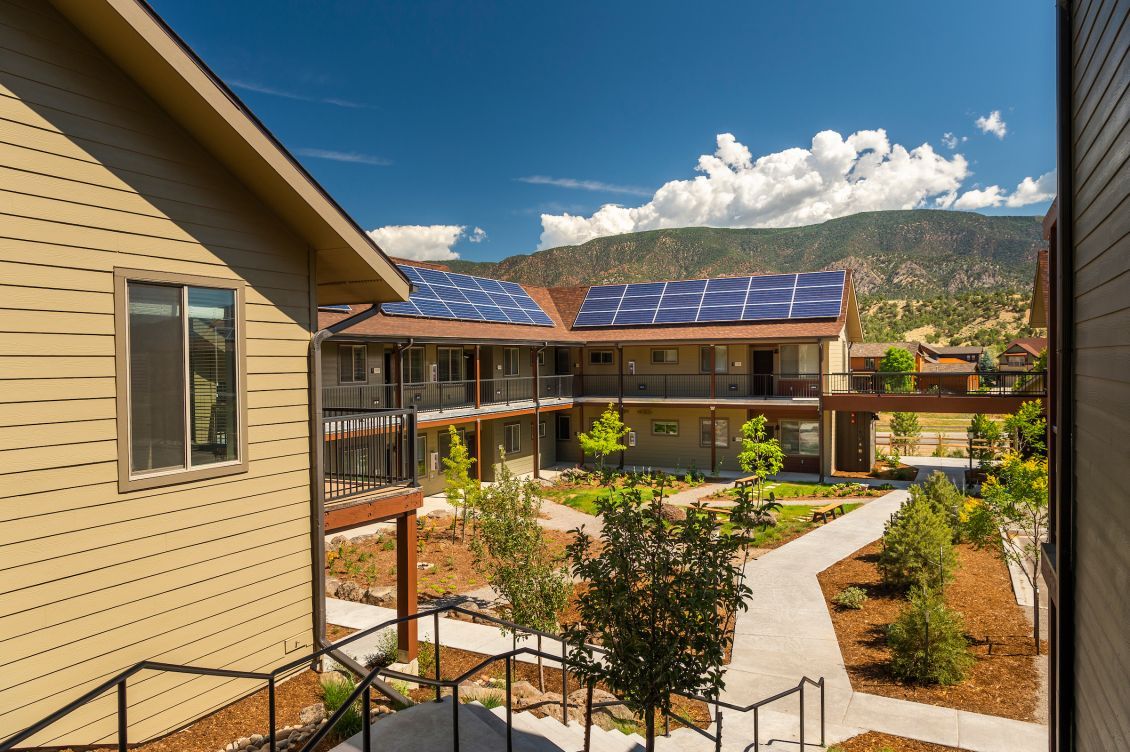As the Inflation Reduction Act (IRA) rolls out, housing agencies around the country are preparing to deploy additional funds, incentivizing developers to incorporate green designs, and boosting cooperation with state energy offices.
Housing finance agencies (HFAs) will play an important role in helping the multifamily sector realize the benefits of the IRA, the groundbreaking law enacted in August 2022 to address the climate crisis that includes more than $18 billion in grants and $36 billion in tax credits for housing-related energy work.
Many housing agencies already require or incentivize energy performance through their own programs or participation in the federal Weatherization Assistance Program. While their roles vary greatly, the agencies have decades of experience in multifamily housing finance and operations, said Robert Henson, senior housing policy specialist at the Washington, D.C.-based National Council of State Housing Agencies.
“There is tremendous diversity among HFAs as far as how much experience they had prior to the IRA in terms of doing this work, but a lot of them have a long history of successful partnerships with the DOE [Department of Energy] and others to bring resources to bear to improve energy efficiency and resilience of multifamily properties,” said Henson, whose nonprofit organization has been helping housing agencies access IRA information, exchange best practices, and expand collaboration.
Housing agencies are well positioned to make recommendations about multifamily properties’ needs; they understand financing mechanisms; and they typically have relationships with developers, state agencies, and others, he said. Seven state housing agencies have applied for the IRA’s Solar for All program as their statewide lead, he said.
Many are strengthening partnerships with state energy departments in response to the IRA. A recent report highlights the benefits of such collaboration, including improved energy affordability; greater equity; better program and technical capacities; and engagement and education of building owners.
A lot of [HFAs] have a long history of successful partnerships with the DOE and others to bring resources to bear to improve energy efficiency and resilience of multifamily properties.
robert henson, national council of state housing agencies
While most states are waiting for additional IRA guidance from federal agencies, some have started new initiatives. For example, Massachusetts recently launched the Massachusetts Community Climate Bank in hopes of attracting private-sector capital and IRA funds.
“There are states looking at innovative financing mechanisms to be able to take advantage of these resources,” Henson said.
Streamlined Financing Mechanisms
States with climate action plans already have valuable connections and systems in place. Minnesota, which has a statewide climate action framework that includes a decarbonization plan for the state’s housing agency, will likely deploy any available IRA dollars through existing programs and structures.

“It really already is a one-stop financing pathway so developers are submitting one application for their building, bringing their capital stack and outside pieces of funding and on the back end, after they apply, we sort through different programs and funding resources that are tailor-made for that building,” said Katherine Teiken, clean energy policy specialist at Minnesota Housing.
“We feel it’s important that, as much as we can, we deploy funds through financing structures that are comprehensive, so we fund everything a building needs, not just a small piece,” Teiken said. “We’re making sure we’re still using financing structures that our developers are familiar with and comfortable with – it keeps things easy and helps with funding navigation.”
There may be opportunities to create new financing programs through some aspects of the IRA, such as the Greenhouse Gas Reduction Fund, she said. But whenever possible, the agency plans to wrap funding into existing streams – something Henson said most states will likely do.
Similarly, New York State Homes and Community Renewal (HCR) the state’s housing agency, has been partnering with the New York State Energy Research and Development Authority (NYSERDA) on the Clean Energy Initiative (CEI) program, allowing developers to only apply once for multiple funding sources. Such a model will likely be replicated to deploy any IRA funds, said Samantha Pearce, vice president of sustainability at the Office of Housing Preservation at HCR.
The state has an ambitious climate action plan, with targets to reduce greenhouse gas emissions by 40% by 2030 and at least 85% by 2050 from 1990 levels.
“We are positioned well to deploy additional federal money because the state’s Climate Leadership and Community Protection Act, established in 2019, provides a roadmap by setting a historic set of goals on the state level that target not only buildings but the entire economy in New York state for decarbonization,” Pearce said.
Incentives to Go Greener
Colorado has had energy-efficiency programs and incentives before the IRA, but the IRA could encourage some developers to seek a higher level of green certification, said Kathryn Grosscup, manager, Housing Tax Credit, at the Colorado Housing and Finance Authority (CHFA).
"CHFA has been working to create opportunities in the Qualified Allocation Plan [the process for allocating housing tax credits] to both allow and in some cases incentivize developers to consider electric-ready or all-electric design in their construction proposals,” Grosscup said. “We have incentives to seek advanced green certifications, including Zero Energy Ready Homes Certification (ZERH), a DOE certification. We've had a great platform in place to really allow immediate opportunity for developers, where eligible, to take advantage of new credits."
One developer working on a 100-unit development was recently able to take advantage of higher credits available under the IRA for providing fair wages, she said.
Officials stressed that cooperation and knowledge sharing will be essential. Colorado recently launched the Multifamily Affordable Housing Electrification Hub, a joint effort by the CHFA in partnership with the Colorado Energy Office, Enterprise, and others. The interactive website includes technical resources, peer learning, and case studies on mechanical systems needed for decarbonization, Grosscup said, adding she hopes it will become useful for other states as they implement the IRA.
Tracking Who Bears the Costs of Climate Transition
The IRA is generating a lot of excitement, but officials said there is still a great need for more affordable housing, and stressed that any new programs must not lead to higher costs for the most vulnerable residents.
“Sometimes an all-electric building design can be really cost-efficient, but sometimes it doesn’t net out to be cheaper than heating with natural gas,” said Mia Watson, special programs manager at the Vermont Housing Finance Agency (VHFA). “We’re really excited that the IRA could be a way to bridge those gaps. But most HFAs will tell you that a lot of the policy decisions won’t happen until there are stable funds available.”

“Responding to climate change is imperative, but we have to examine projects carefully to ensure our efforts are also lowering costs,” Watson said. “We want to ensure that we are not making low-income households bear the cost of climate transition by redirecting resources that are supposed to support them.”
The IRA has already had an impact in the marketplace, with more companies and individuals pursuing work in the green energy sector. A trained workforce will be needed, especially in rural and remote areas, experts said. Individuals who understand financing and how to track and measure energy savings will also be in demand, NCSHA’s Henson said. The Alaska Housing Finance Corporation is an example of an agency experienced in this area. The agency ran a large home energy rebate program and developed an auditor training program in response.

The IRA offers an unprecedented opportunity to create climate-resilient housing, but it must consider different needs in different areas, Henson said.
“The needs in Vermont are very different than in New Mexico, so we really need to tailor these resources,” Henson said. “Is the issue extreme cold or extreme drought? The potential for wildfires or flooding? Being able to look at resilience, energy efficiency, and decarbonization in a very holistic way that’s cognizant of the geographic and environmental diversity will be critical.”
Vesna Jaksic Lowe has written for the New York Times, the Washington Post, and the New York Daily News. This is the third in a series of articles exploring how the affordable housing sector can maximize the potential of the IRA. Read more from the series: Solar Success: How the IRA will Help Solar Gardens Power Affordable Housing and From Roadmaps to Software: Tools to Help Leverage the IRA.

